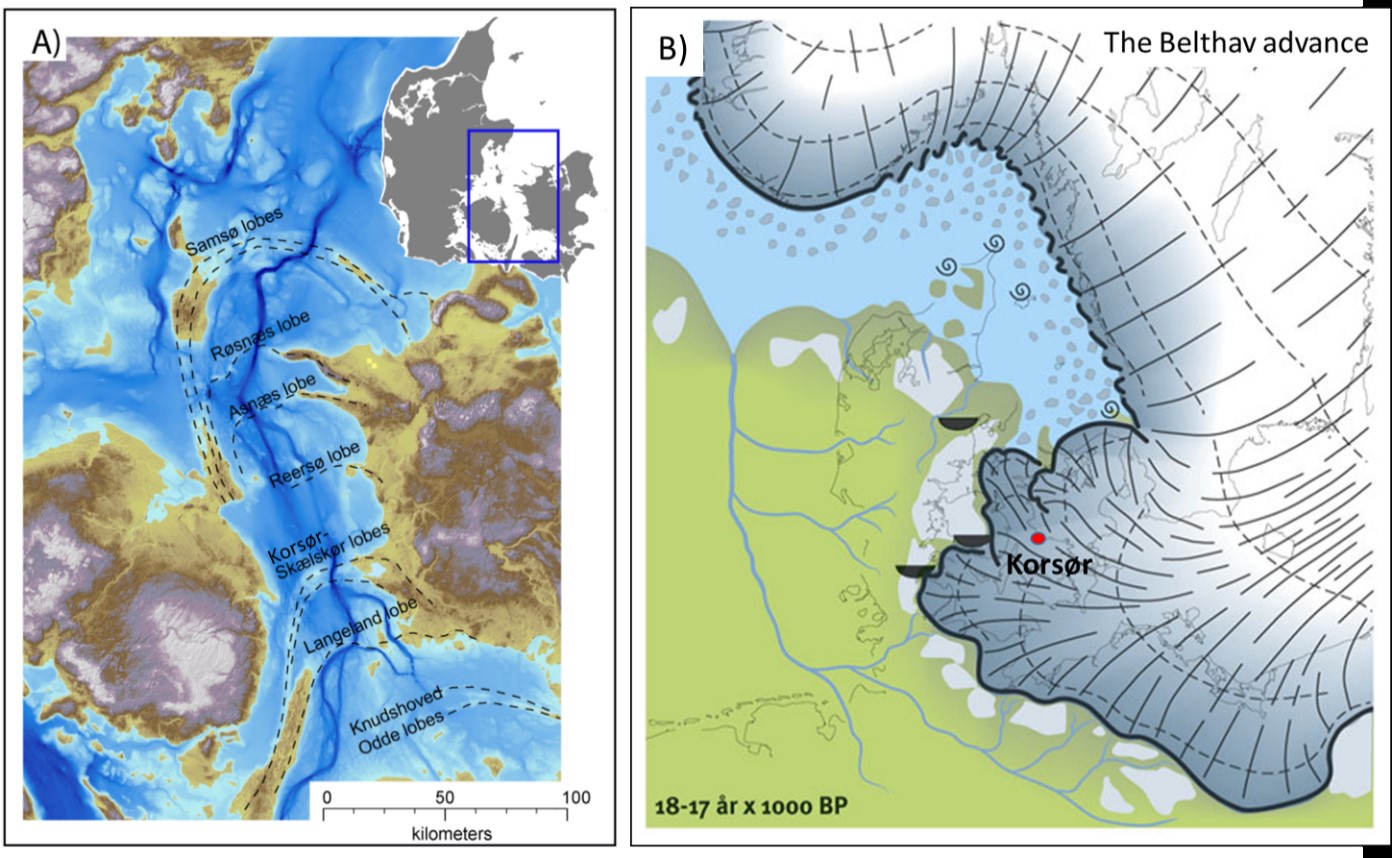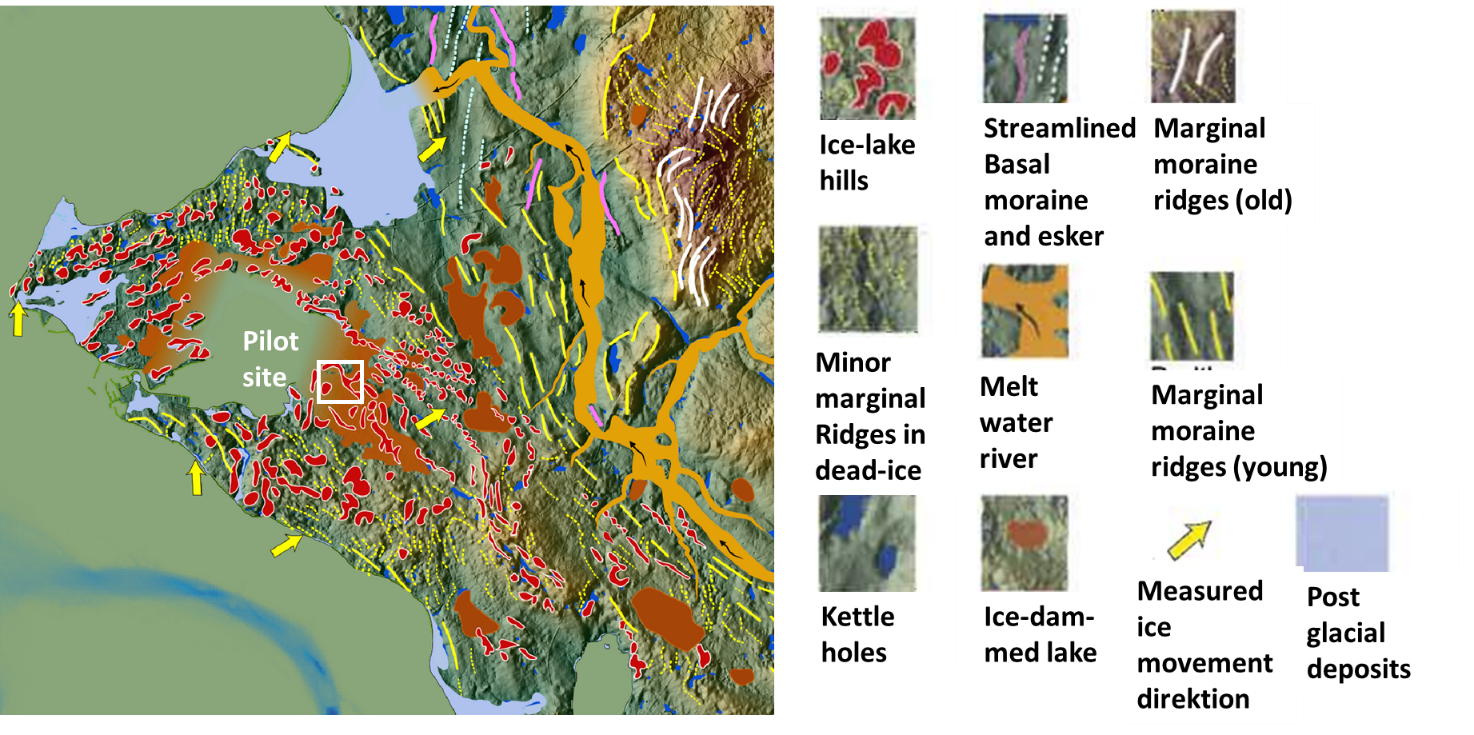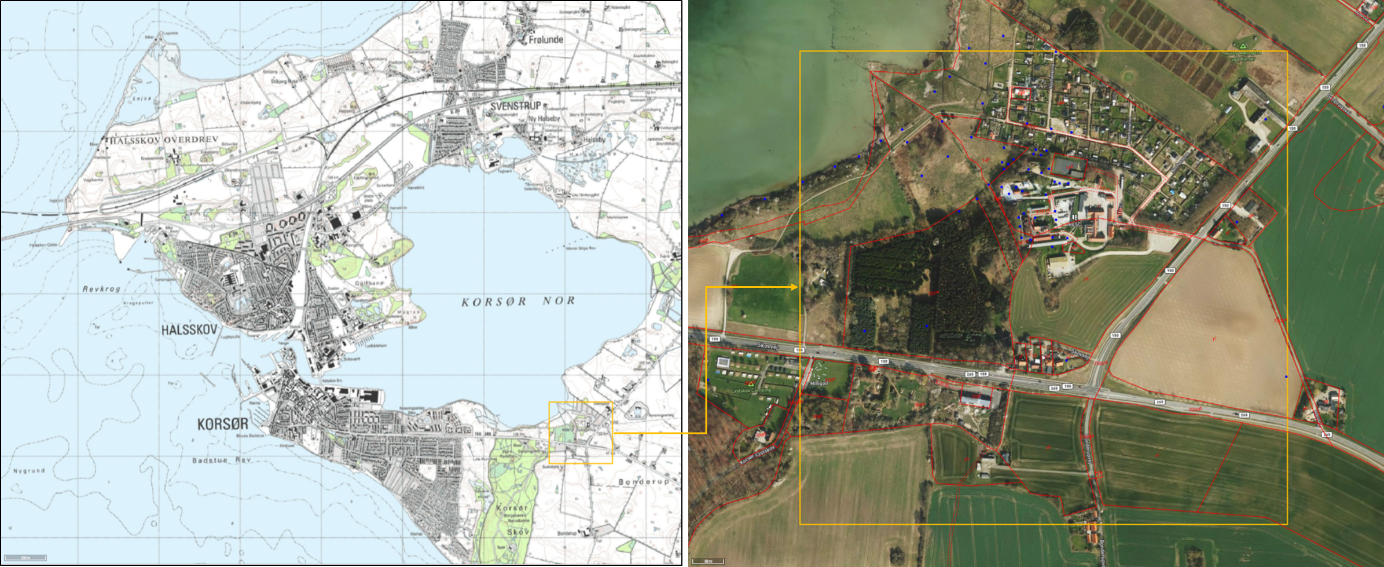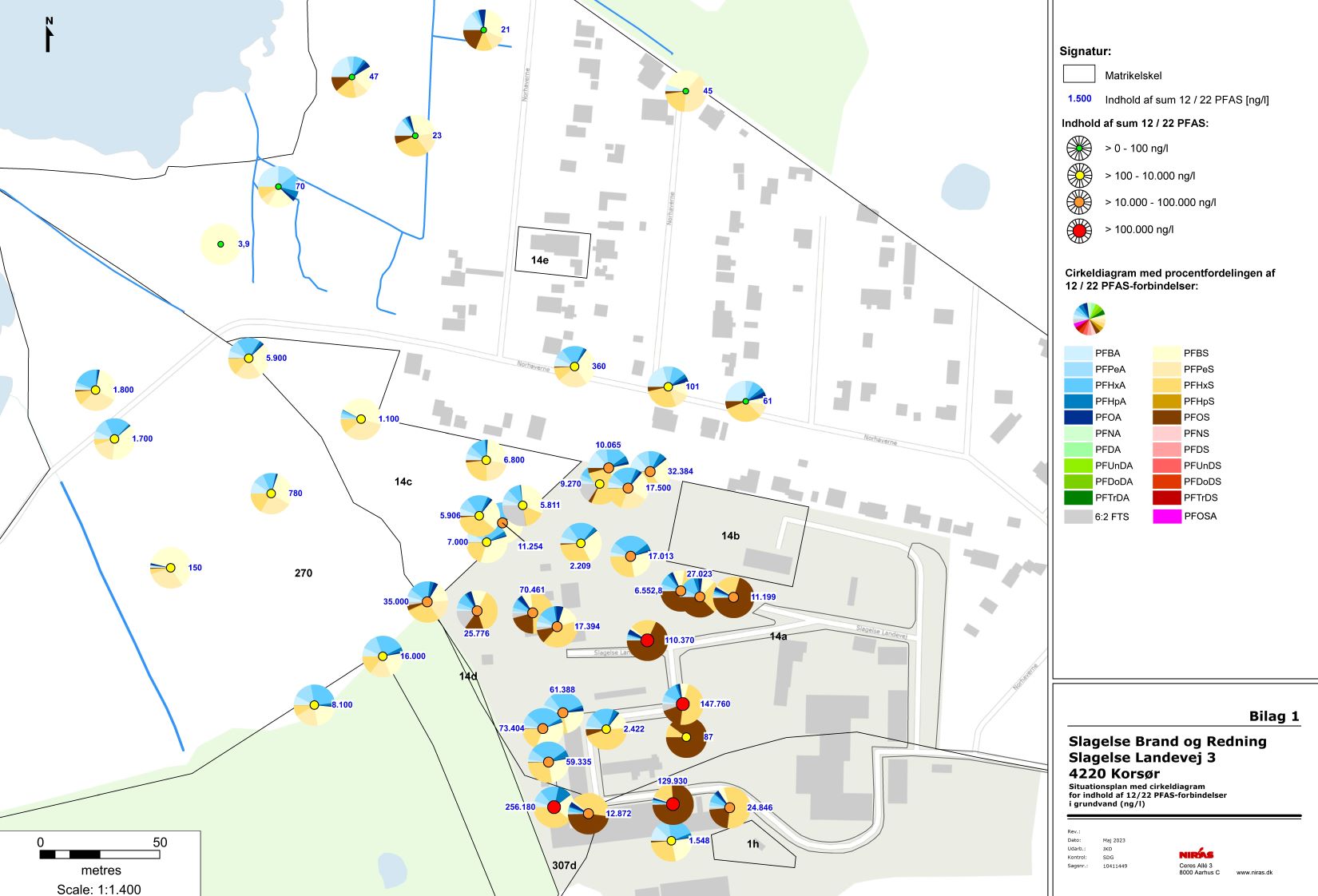Active Fire Academy.
PFAS in soil, groundwater, surface water, grass and biota.
Plug-n-play test facilities and access to meeting rooms.
P&T plant.
CONTACT
PFAS-test center, Former Korsør Fire Academy
RESC Rednings- og SikkerhedsCenter
Slagelse Landevej 3
DK-4220 Korsør
Bente Højlund Hyldegaard
Region Sjælland
T: 29769307
E: behyl@regionsjaelland.dk
Site owner:
Slagelse Municipality
PRESENTATION OF THE SITE
REASON FOR THE SITE
The site is an active fire academy heavily contaminated with PFAS due to former use of aqueous film forming foam that contained significant amounts of PFAS. These contaminants have been nicknamed “forever chemicals” due to their persistent properties, which poses a challenge to the common remediation practices. Based on the need for adaption and development of new technologies for investigation and remediation of PFAS-contaminated sites, a partnership was established in 2022 to facilitate this by offering access to the first national PFAS-test center. The partnership consists of Slagelse Municipality (site owner and local environmental authority), RESC Rednings- og SikkerhedsCenter (the onsite active fire academy) and Region Zealand (regional environmental authority).
The partnership wishes for this test center that it will become a point of gathering for knowledge on PFAS contamination by contributing to the development of viable solutions for investigation and remediation of PFAS contaminated sites nationally and internationally. Onsite meeting facilities support this.
GEOLOGY
Regional geology and geomorphology
The Korsør area is dominated by glacial deposits, primarily clay/sandy tills and meltwater-sand/clay from the last Ice age. Post glacial deposits such as peat, freshwater sand and clay are deposited in low areas, and marine sandy and clayey sediments appear close to the sea.
The glacier advance, forming the majority of the landscape around Korsør, is related to the so-called Great Belt Advance, which transgressed the area approximately 17-18.000 BP. During the retreat of the Great Belt glacier, a number of minor re-advances formed the characteristic lobate marginal moraines that are scattered from Langeland and northwards to the Island of Samsø:
The general geomorphology of the area is dominated by a mixture of ice-marginal landforms, such as marginal moraines, overprinted by a so-called dead-ice relief with numerous classical ice-lake hills and kettle holes:
The Ice-lake hills were formed in ice-lakes close to the margin of a retreating glacier front. The lakes were gradually infilled with meltwater-deposits and when the surrounding ice melted, the lake sediments formed characteristic hills. During periods with strong melting or rain events meltwater is flushing sand/silt/clay into the lakes. Mudflows are also creeping into the lakes depositing flow-tills on the meltwater sand/silt/clay. During the deposition the surrounding ice is still active and push and deform the sediments, thus resulting in very complex geological conditions.
Korsør Fire Academy is situated on such an ice lake hill with a top level of approximately +20m DVR90 next to a local marine inlet “Korsør Nor” (Korsør Cove):
The hill is one of several characteristic hills in the area, and it is primarily consisting of clay till overlain by meltwater sand/clay/sandy flow-till in the upper 10-15 m. To the west marine deposits, dominate the raised marine foreland towards the sea. Below cross-section is illustrating the distribution of sediments under the Korsør Fire Academy. It appears at least three to four different levels of groundwater is present. One is approximately +10,6 m DVR 90, another groundwater table, is situated at +8,2 m DVR 90, a third one is situated +5,6 m DVR 90 and finally the groundwater table on the lower area is situated about + 1,7 m DVR 90 falling towards the sea to the northwest. Apparently, the groundwater is seeping towards NW and the sea. The different groundwater levels implies that the geology is complex and that the sediments are deformed.
More details on the geological settings and a 3D geological model of the area can be found in the collection of Technical documents. An animation of the geological model incl. site investigation data has been recorded.
CONTAMINATION SITUATION
The site has hosed a fire academy since 1969 and to the present day. Until 2001, the fire academy used fire-fighting foam containing PFOS. It is the fire academy activities, which have caused extensive PFAS contamination. Overview of the site and its surroundings:
In soil, PFOS and PFHxS are the most dominant components (see figure below). The highest concentrations of PFAS Σ4 (PFOA, PFOS, PFNA, PFHxS) are found in the top soil (0.2 m bgs) and as high as 1,447 µg/kg dry matter (PFAS Σ12 1,450 µg/kg dry matter). In addition, sediment samples from a ditch connecting the site to Korsør Cove revealed concentrations of PFAS Σ4 up to 3,177 µg/kg dry matter. Near certain fire training facilities, significant content of hydrocarbons in soil is also reported.
In the secondary groundwater located at 1-6.5 m bgs, PFAS Σ4 is detected in every water sample extracted and in concentrations ranging from 90-123,000 ng/l. For PFAS Σ12, concentrations up to 256,180 ng/l are observed. The composition of PFAS components in groundwater is dominated by long-chained PFAS in the source area, whereas the shorter-chained PFAS components are more prevalent downstream of the site (see figure below). Only one water sample, which was extracted next to a leaking well, contained hydrocarbons (B4).
The general groundwater flow pattern is towards north-north east in the direction of Korsør Cove. However, the geology in the area is highly complex (see Geology), wherefore the groundwater in which the wells are screened may not be a continuous aquifer.
In the surface water of Korsør Cove, concentrations of the specific component PFOS of up to 77 ng/l is detected near the coastal line facing the site. Surface water collected within the ditch connecting the site to Korsør Cove contains significantly elevated concentrations of up to 34,000 ng/l. Since PFAS compounds preferentially accumulate in the air-water interface, a foam sample from the Cove has been collected at the easternmost point of the Cove. The foam contained 16.000 ng/l of PFOS.
The site investigation also included assessment of biota living in the Cove and grass growing on the meadow downstream of the site. Both demonstrating accumulation of PFOS.
Since 2021, all drain water from the site has been collected and treated in an on-site P&T plant (illustration below). In addition, since 2023, on-site infiltrating water collected immediately downstream of the site, via a 170 m long drain placed at the meadow, is also treated in the P&T plant. This to limit further leaching of contamination from the site to the surroundings. The treated water is discharged to a nearby WWTP. Additional information about the P&T plant.
More details on the site can be found in the collection of Technical documents (some in Danish).
PRACTICAL
Access to the site
By car

Access conditions for heavy vehicles are good.
By public transportation
The nearest bus stops (line 901) are located within a 300 m walk from the PFAS-test center and operates at half hourly services to and from Slagelse Train Station and Korsør Train Station. These train stations are connected to the main public infrastructure. Please consult the public transportation guide for details: www.rejseplanen.dk.
Entering the meeting facilities
Upon arrival, consult the reception. Opening hours Mon-Thurs 07:30-15:30, Fri 07:30-12:30.
How to book meeting facilities
Approach the administration at RESC for bookings on T: +45 58 57 97 00 or E: resc@slagelse.dk. The booking is confirmed once the administrator has accepted the request.
Access to the on-site staff canteen
Approach the administration at RESC for ordering of lunch on T: +45 58 57 97 00 or E: resc@slagelse.dk. The booking is confirmed once the administrator has accepted the request. Be aware that payment is via invoice only.
Please note, that the order must be placed 8 days prior to the visit to accommodate planning.
Facilities
Meeting facilities
4 meeting rooms, which fit approximately 10-50 participants. Each meeting room is equipped with a screen or projector. There is access to a coffee machine. See Access to the site for info on how to book the meeting facilities.
Canteen
The on-site staff canteen is available to users of the test center. Please note, that an order must be placed prior to the visit. See Access to the site for more details.
Toilets
Several toilets are accessible on-site within opening hours: Mon-Thurs 07:30-15:30, Fri 07:30-12:30.
Some are located next to the meeting facilities, others near the canteen. If in doubt, please approach the reception.
Wireless internet access
The on-site active fire academy, RESC, is kindly offering access to their WIFI in the buildings. Instructions on login is provided on-site.
Test infrastructure
By car

Access conditions for heavy vehicles are good.
By public transportation
The nearest bus stops (line 901) are located within a 300 m walk from the PFAS-test center and operates at half hourly services to and from Slagelse Train Station and Korsør Train Station. These train stations are connected to the main public infrastructure. Please consult the public transportation guide for details: www.rejseplanen.dk.
Entering the meeting facilities
Upon arrival, consult the reception. Opening hours Mon-Thurs 07:30-15:30, Fri 07:30-12:30.
How to book meeting facilities
Approach the administration at RESC for bookings on T: +45 58 57 97 00 or E: resc@slagelse.dk. The booking is confirmed once the administrator has accepted the request.
Access to the on-site staff canteen
Approach the administration at RESC for ordering of lunch on T: +45 58 57 97 00 or E: resc@slagelse.dk. The booking is confirmed once the administrator has accepted the request. Be aware that payment is via invoice only.
Please note, that the order must be placed 8 days prior to the visit to accommodate planning.
Requirements for project owners
Project owners
In order to ensure, among other things, optimal conditions for each individual project, Region Zealand must approve all projects on behalf of the partnership that runs the PFAS-test center. Please submit a project application with, in all confidentiality, full transparency in relation to technical and chemical details. Template is available here: dansk, English.
For projects intending to perform testing on-site for a given period of time, please consult this checklist.
Be aware, that conditions apply to supply of PFAS contaminated water from the buffer tanks and the possibility of discharging process water to the on-site permanent treatment plant (guideline).
The project owner holds the sole responsibility of obtaining necessary permission(s) of the local municipality. Documentation must be shared with Region Zealand.
Before access to the site, we also ask you to sign an agreement, which commits the project owner to take responsibility for any damages under Danish law and for not increasing the cost of future efforts to remediate the contaminated site.
All visitors
Be aware that the site is an active fire academy; hence show consideration for the daily operation. Also, please treat the facilities with respect and tidy up after yourselves.
Technical documents
- 2021-04-19 Historical review and site investigation project proposal Former Korsoer Fire Academy
- 2021-06-29 Investigation of PFOS in grass from the meadow downstream of Former Korsoer Fire Academy
- 2021-08-26 All appendices-Preliminary contaminated site investigation at former Korsoer Fire Academy
- 2021-08-26 Preliminary contaminated site investigation at former Korsoer Fire Academy
- 2021-08-26 Map hydraulic head Appendix preliminary contaminated site investigation
- 2021-08-26 Map hydrocarbons in groundwater Appendix preliminary contaminated site investigation
- 2021-08-26 Map hydrocarbons in soil and sediment Appendix preliminary contaminated site investigation
- 2021-08-26 Map overview Appendix preliminary contaminated site investigation
- 2021-08-26 Map PFAS in groundwater Appendix preliminary contaminated site investigation
- 2021-08-26 Map PFAS sum 12 in soil and sediment Appendix preliminary contaminated site investigation
- 2021-08-26 Map PFAS sum 4 in soil and sediment Appendix preliminary contaminated site investigation
- 2021-08-26 Map site plan Appendix preliminary contaminated site investigation
- 2021-10-06 Investigation of PFOS content in aqueous film forming foam at former Korsoer Fire Academy
- 2022-02-11 Analysis-PFAS in surface water of Korsoer Cove
- 2022-02-11 Map of PFOS in surface water of Korsoer Cove
- 2022-06-21 Analysis-PFAS in surface water of Korsoer Cove
- 2022-09-07 Hydrogeological groundwater model Former Korsoer Fire Academy
- 2023-05-11 Fingerprints PFAS in water samples
- 2024-06-21 Geological settings incl. 3D model of Former Korsoer Fire Academy area
- 2024-06-21 Appendix geological model - high resolution figures
- 2024-08-21 Fingerprints PFAS in soil samples
- Ansøgningsskema Brug af testcenter dansk version 14.05.2023
- Application form Use of PFAS-test center English version 14.05.2023
- Checklist for development projects allocated a test area at the PFAS-test center 08.07.2025
- Guidelines for PFAS contaminated water at the PFAS-test center 08.07.2025
Ongoing projects
ARAGORN - Achieving Remediation And GOverning Restoration of contaminated soils Now
Healthy soils are essential for providing food and clean water, in hosting biodiversity and mitigating climate change effects. However, more than 60% of EU soils are considered unhealthy, with potentially 2.8 million sites being contaminated.
ARAGORN highlights the need for a holistic approach to soil remediation that considers diverse land managers' needs and societal contexts to minimise risk and ultimately ensure successful restoration of land. ARAGORN focuses on tackling hotspot sites polluted with persistent pollutants (PFAS, organochlorine and bromine compounds, petroleum/coal pollutants and metals).
EU Horizon project involving 17 partners across the EU.
Read more here: https://aragorn-horizon.eu/the-project/
Genetics of PFOS degradation
This project will screen for novel microorganisms that can perform defluorination of PFAS as secondary metabolism.
Project documents
P&T plant for management of PFAS contaminated surface water, runoff water and fire-training water
Ultraaqua A/S constructs a permanent and full-scale treatment solution for surface runoff, drainage water and fire-training water from the total area of the fire training site. The water treatment plant will treat the water efficiently to remove PFAS before release to meet the discharge limits. The collected PFAS will be destructed on site in a UV-process to non-toxic components under normal ambient conditions.
See illustration under "Contamination".
Technology owner: Ultraaqua.
PFAS Cleanup: A combined photocatalytic-fungal method to remove PFAS from fire-fighting foam
We are studying a novel combination of chemical (photocatalytic / NTP) and biological (fungal) treatments to remediate PFAS-contaminated waste streams. We are specifically using photocatalysis and fungal treatments to degrade and defluorinate PFAS in Aqueous Fire Fighting Foams.
Read more here: https://www.sfi.ie/challenges/healthy-environment-all/pfas-cleanup/
Partner: University College Dublin, Ireland.
PFAS demonstration projects
Governmental grant for two projects on thermal conductive remediation of PFAS contaminated soil. Both conducted in containers.
The Governmental grant is implemented by the five Danish Regional Authorities.
- Arkil together with Haemers have designed a set-up with heating of the soil to 350 ◦C by patent protected intelligent burners fueled by propane. The PFAS evaporate and is subsequently destructed in the burners at 1,400 ◦C. As a precautionary measure, vapor is passing through GAC.
- Krüger Veolia have designed a set-up with heating of the soil to 400-500 ◦C by hooking up to the electric grid. Based on feasibility studies, some PFAS will be destructed within the soil matrix, others evaporates and subsequently destructs in the patent pending defluorinator at 600 ◦C. Inorganic F is removed in a scrubber. As a precautionary measure, vapor is passing through GAC. Blog I. Blog II. Blog III.
Scenarios - beyond state of the art monitoring and remediation technologies
The goal is to close the knowledge gap and achieve breakthrough TRL advances in the toxicology, detection and remediation of probably the most objectionable and widespread class of contaminants -PFAS-, with an unprecedented energetic balance and virtually no external chemical additives. A major effort is underway to develop Integrated Approaches to Testing and Assessment (IATA) of PFAS, including the new generation of congeners, to assist EC and EU countries in decision-making on these substances for environmental safety and human health.
EU Horizon project involving 19 partners from 10 European countries and Israel.
Read more here: https://scenarios-project.eu/




















